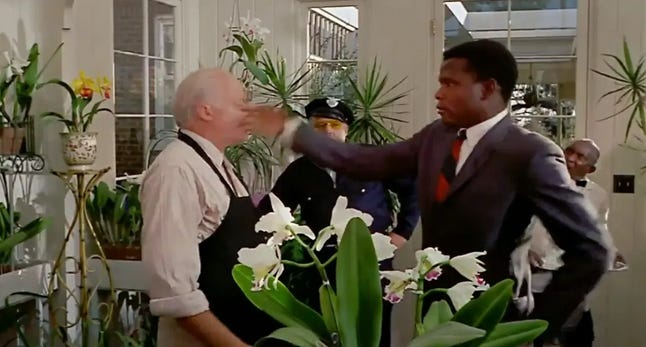PROGRAMMING NOTE: This is our 100th post! We’ve really written a hundred of these? That’s silly. But I guess we know lots of things now.
“You sure are sure of yourself Virgil,” says police chief Bill Gillespie (Rod Steiger). He’s browbeating Virgil Tibbs (Sidney Poitier), a Black homicide cop from Philadelphia who’s been shanghaied into helping the police of Sparta, Mississippi, solve a murder. But Gillespie resents a Black cop showing up his department’s good ol’ boys. “[Virgil’s a] funny name for a n----- boy from Philadelphia. What do they call you up there?” Gillespie asks. Virgil’s reply?
Look, I was aware of this line from its omnipresence on Greatest Movie Quotes lists and from seeing it in that “MGM means great” movies ad from James Bond VHS tapes, but you know what? When you see it in context, its overexposure costs it none of its indignity and anger and power. This line deserves its flowers.
The murder mystery at the heart of the film may be paint-by-numbers, but both Poitier and Steiger do their best to elevate the material. And director Norman Jewison nails the vibe of Sparta: it’s a place of seething malice and legitimate danger if you’re Black. It’s tense and angry, hot and sweaty, ugly and oppressive.
Rating: 7/10. Yes, “tense,” “angry,” “hot,” “sweaty,” “ugly,” and “oppressive” were all compliments.
Cast and Crew
The sweatiness of In the Heat of the Night leads to it being a remarkably unglamorous movie, and no one is sweatier or less glamorous in it than Rod Steiger. He’s wet and flabby, he’s constantly chewing gum, and his men are constantly disrespecting him. I’m not sure it screams “Best Actor,” but hey, I guess this was to make up for “snubbing” Steiger for The Pawnbroker.1
Besides The Pawnbroker, we’ve seen Steiger in supporting roles in On the Waterfront and The Mark. We’ve also mentioned his roles in Oklahoma! (1955, he’s poor Jud) and Doctor Zhivago (1965, he’s the guy who rapes Lara). In the Heat of the Night will be the last starring role we’ll see Steiger in2, but he had film roles into the 2000s.
After the Oscar win, Steiger played a murderer in No Way to Treat a Lady (1968), then took some big swings that didn’t connect: a gay NCO in The Sergeant (1968), a man whose tattoos tell the future in The Illustrated Man (1969)3, and Napoleon in Waterloo (1970). Waterloo was a big-budget bomb that producer Dino De Laurentiis said bombed because of the film’s “lack of stars” (ouch).

The ‘70s found Steiger making movies in Italy and France and not really getting good returns, and in the ‘80s he made B movies and battled depression. We’ll assuredly touch on some later Steiger films in our yearly recaps, including The Amityville Horror (1979) and, uh, Mars Attacks! (1996), but who cares. Even if he never recaptured the magic of In the Heat of the Night, you can’t take a damn thing away from Rod Steiger.
And then there’s Sidney Poitier, in the first of two 1967 movies where his Blackness challenges everyone around him. Man, we already did this with The Defiant Ones. It’s kind of a drag.
That’s no knock on Poitier, though—he’s really good in this film. In fact [lowers voice] the wrong guy was nominated for Best Actor. But even with no Oscar recognition, we can still marvel at Poitier’s 1967: this film, To Sir, with Love, and the film we’re watching next week. An all-time acting year right there.4
Quick hits:
Lee Grant played the wife of the murder victim. She was nominated for Best Supporting Actress four times, including for the Warren Beatty vehicle Shampoo (1975). She was also one of the stars in “Peyton Place.”
A different kind of quick hit: Virgil slapping a racist white dude.
Canadian director Norman Jewison was behind the camera for this one; we saw his direction last in The Russians Are Coming the Russians Are Coming. After two films, I’m not sure if I’ve got anything to say about Jewison’s style—though ChatGPT offers “versatile and humanistic,” if that helps.
Hal Ashby got his start editing films for Jewison (he actually won an Oscar for this one) and we’ll see him in this column as a director soon enough.
Like in The Pawnbroker, Quincy Jones handled the film score, while the title song was done by Ray Charles.
The Trivia
Gillespie indicates that he thinks “Virgil” is a funny name, so we can figure he doesn’t have much familiarity with the Roman poet Virgil (70 BC – 19 BC). To make sure you don’t look like an ignorant Mississippi police chief, let’s fill you in on some details about the works of this poet of antiquity.

Virgil has three extant major works, all written in dactylic hexameter.5 Consider these first two an appetizer. The Eclogues (from the Greek for “to select”) were ten poems depicting idealized rural life.6 The Georgics (from the Greek “agricultural”) served as a farming manual and a literary work celebrating the virtues of hard work.
Okay, so he wrote about farming and rural life. Is that it? Nope! He also wrote the Aeneid, the founding myth and national epic of Rome, written under the rule of Augustus Caesar7 at the beginning of the Roman Empire.
Specifically, it tells the story of Aeneas, a Trojan prince seeking a second home after the fall of Troy. Aeneas journeys across the Mediterranean until reaching Italy, where he does colonialism fights to secure his people’s future.
Some notable parts of the Aeneid:
The phrase “Arma virumque cano” (“I sing of arms and the man”) is its famous opening line. We mentioned that when we talked about the plays of George Bernard Shaw.
It contains the story of the Trojan Horse. Here’s a fun detail: Trojan priest Laocoön doesn’t want to accept the horse (“I fear the Greeks even when bearing gifts”) and throws his spear at it, after which two sea serpents devour him and his sons.
But you gotta know Aeneas’ tragic love affair with Dido, the legendary founder and queen of Carthage.8 They fall in love but Aeneas abandons her to continue his quest to found a city in Italy. Dido does not take this well: she kills herself when he leaves.9 This provides a backwards, pseudo-historical explanation for the constant strife between Italians and Carthage.
Aeneas journeys to the Underworld and sees some of our favorite Underworld stuff, like Cerberus (three-headed dog), Tartarus (the lowest part of the underworld), and Elysium Fields (basically heaven). He also runs into his ex Dido down there, which goes exactly how seeing your ex always goes.
Aeneas finally lands in Latium10, where the king there agrees to marry his daughter off to him. But, love triangle: she was originally promised to Turnus, prince of the Rutulians, so there’s gotta be war and Turnus has gotta die.
Aeneas’ descendants include Romulus and Remus, founders of Rome.
Speed Round: Other Roman Poets
You may want to mix up the poet Virgil with other Roman poets. Don’t do that! Here are three other guys you should know and the things you’ve gotta know them for:
Catullus (c. 84 – 54 BCE). Love poems dedicated to Lesbia.
Horace (65 – 8 BCE). He wrote “Odes,” “Epodes,” and “Satires,” along with “Ars Poetica” (on the art of poetry).
Ovid (43 BCE – 17 CE). Best known for “Metamorphoses,” an epic retelling of Greek and Roman myths.
Odds and Ends
Virgil (the poet, not Mr. Tibbs) was Dante’s guide through Hell in the Divine Comedy…Richard Linklater called third-billed Warren Oates a “god who walked the Earth” while talking about Oates’ performance in Two-Lane Blacktop (1971)…in The Lion King (1994), Pumbaa bellows a line you might recognize…Beah Richards played the abortionist; we’ll see her playing Sidney Poitier’s mother next week…“The Death of Virgil” is a 1945 novel by Hermann Broch about, what else, the death of Virgil.
The character of Virgil Tibbs had many more adventures, mostly outside of Mississippi. Novelist John Ball created the character and wrote many more novels about him. Poitier reprised the role in two sequels: They Call Me Mister Tibbs! (1970) and The Organization (1971). Later, a TV show based on the film aired from 1988 to 1995. It starred Carroll O’Connor in the Steiger role and Howard Rollins as Virgil Tibbs.
Wait—they turned this sweaty, tense film about race relations into some brightly-lit, soapy procedural? And it aired for seven seasons? Jeez.
You may recall that Lee Marvin won over Steiger for his role in Cat Ballou.
Though he’s got a minor role in a 1999 film we’ll be watching that happens to also be directed by Norman Jewison.
That last one is based on a set of Ray Bradbury stories. The Illustrated Man also starred Steiger’s (soon to be ex) wife Claire Bloom, who we’ve seen in Richard III and The Spy Who Came in from the Cold.
Here’s a ScreenRant listicle about 10 times actors released 3 or more great movies in a single year, but their list kinda sucks.
This video explains accentual-syllabic verse in a cogent way. The 2nd word tells you how many metrical feet each line has and the 1st word tells you how the stress in each foot is divvied up. “Hexameter” means six metrical feet; “dactylic” is a triple meter with each foot having a stressed-unstressed-unstressed (also shown as | ' ˘ ˘ | in poetry stuff).
As such, they were also called the Bucolics. “Bucolic” comes from the Latin for “cowherd” and is used today as a synonym for “pastoral.” It’s fine if you want to work “bucolic” into your spoken vocabulary, but it’s also fine if you don’t do that.
Though she was initially the queen of the Phoenician city-state of Tyre.
Dido and Aeneas were the subject of a major 1689 opera by Henry Purcell. Here’s an absolute gutting aria from the opera performed by Jessye Norman, one of my favorite sopranos. Yeah, you’re reading a newsletter by a guy who has favorite sopranos, you’re just gonna have to deal with that.
Yeah, this is where we get the word “Latin”: the Latini settled in Latium and spoke a dialect called Latin.






100 dancing conga rats for you...keep on watching and posting!